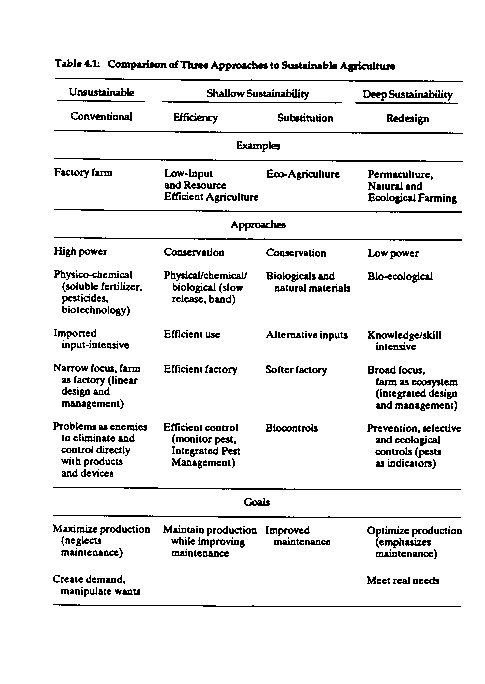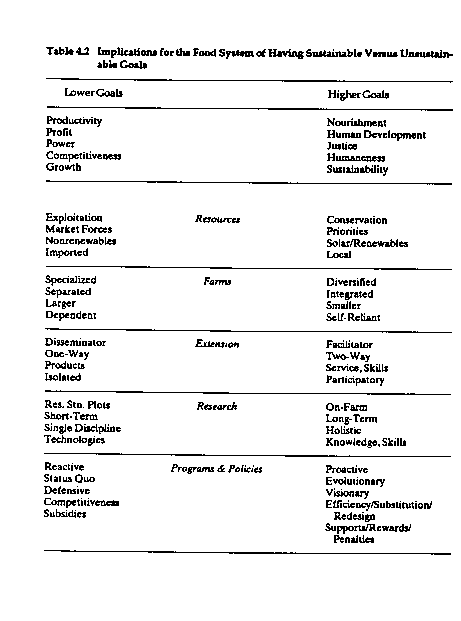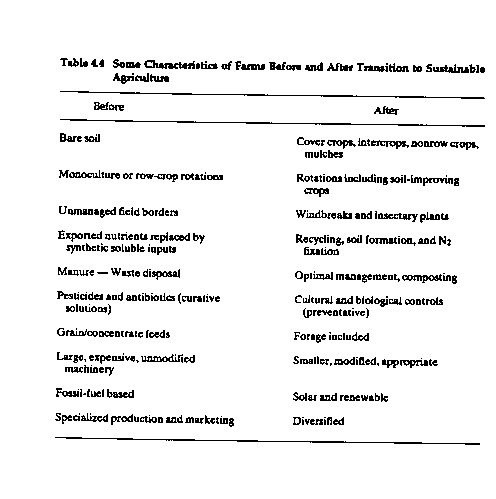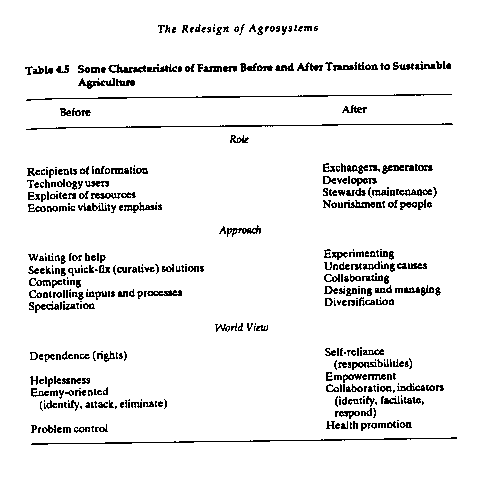

EAP Publications | Virtual Library | Magazine Rack | Search
Join the Ecological Solutions RoundtableEAP Publication - 34
Stuart B. Hill
At some point in the future, agronomists will wonder how present day scientists could have continued to knowingly advocate the expansion of specialized production systems that emphasize practices such as chemically managed row-crop monocultures, which result in soil erosion and de gradation, and water exhaustion and contamination; or knowingly to stand idly by in the face of deforestation and desertification, loss of biodiversity, displacement of farmers and loss of rural communities, and increased dependence on nonrenewable resources, synthetic chemicals and antibiotics, subsidies, and markets that meet distant luxury desires versus local basic needs (Brown et al. 1984).
My explanation of why this madness continues may be as shocking for the readers as witnessing the present level of degradation is for me. Throughout history we have invariably blamed others for our tragedies-- the gods, other nations, certain groups within society, lack of resources and power, multinationals, and political incompetence--but we have rarely examined the contribution of our own behavior, accepted our responsibilities , and set out to change our behavior . Thus my analysis of the situation is primarily psychosocial, rather than political, and that is exactly what makes such a proposition so difficult to accept, because for me this requires that I first recognize and act On my responsibilities and change myself before pointing fingers at others.
My thesis is that, because throughout history people have been psychologically wounded (Demause 1982), they have frequently established inappropriate goals, and have repeatedly done inappropriate (and unsustainable) things to achieve them, things that continue to cause major harm to both people and the planet (Hill 1992; Meadows et al. 1992). For example, the widespread hunger for power and control within families and societies, and the common obsession with the elimination of enemies, including insect pests, may have their roots in the control and manipulation of children and their treatment in some families as "pests." As societies we act out these distresses with devastating consequences that range from widespread malnourishment and starvation to mental depression and degenerative diseases, to environmental degradation, to social decay, to economic crises and political unrest.
If we were managing our lives and nations in appropriate ways we would not be in this mess. Yet the predominant responses to this "feedback" from our behavior have been denial, conducting endless studies of each problem in isolation, the seeking of curative (magic-bullet) solutions, and making symbolic versus substantive changes to the design and management of our affairs. This not only reduces the options available to future generations. , but perpetuates the problems and deprives each of us of experiencing a sense of meaning and fulfillment within our lives . In this paper I will argue for environmental sustainability, discuss what this implies for the design of national and local food systems, and suggest what must be done to implement such sustainable systems.
The foregoing observations both raise, and provide possible answers to, a number of questions. Why, for example, do we not yet have a logical and universally acceptable definition of sustainability, and why have most institutions emphasized economic over environmental sustainability (WCED 1987)? Planet Earth is our environment and our home, and "absolute" requirements (for water, air, nutrients, freedom from biocides, etc.) must be met if it is to remain a place in which present and future generations can survive. Economics, on the other h and, should be used as a tool to help us to live in ways that are consistent with our higher values, and as a consequence its characteristics are "relative." When used appropriately, economics is a tool for evaluating the costs and benefits associated with alternative courses of action. To achieve sustainability we must learn to conduct our affairs within the limits of environmental absolutes, and not continue to delude ourselves that we can only do this if we can afford it (Hill 1990a, 1991).
The widespread failure of our societies to institutionalize environmental ethics is not surprising; unlimited exponential growth, rather than restriction, has characterized human behavior in the industrialized world, particularly since the middle of the last century. It has been estimated that at that time 94 percent of the energy used in the world came from the muscles of people and domestic animals; now over 94 percent comes from fossil fuels (Othmer 1970). In fact, industrialized societies have functioned very much like drug addicts: willing to do almost anything to ensure ongoing access to the desired resources, including going to war to secure this access , and blind to the consequences of the us s of these resources and of our addictive dependence upon them (Slater 1980; Schaef 1987). It follows from this that a genuine definition of sustainability must necessarily spell out restrictions on our behavior and provide guidelines for appropriate goals.
Environmental sustainability implies the following:
1. Meeting the basic needs of all peoples, and giving this priority over meeting the greeds of a few
2. Keeping population densities, if possible, below the carrying capacity of the region
3. Adjusting consumption patterns and the design and management of systems to permit the renewal of renewable resources
4 . Conserving, recycling. and establishing priorities for the use of nonrenewable resources
5. Keeping environmental impact below the level required to allow the systems affected to recover and continue to evolve
An environmentally sustainable agriculture is one that is compatible with and supportive of the above criteria.
A more important question relates to why these directives have yet to be taken seriously by most individuals and societies. To help recognize these real issues I distinguish between shallow (short-term, symbolic) and deep (long-term, fundamental) sustainability (Table 4.1). Shallow sustainability focuses on efficiency and substitution strategies with respect to the use of resources. It usually accepts the predominant goals within society without question, and aims to solve problems by means of curative solutions. Deep sustainability, in contrast, re-evaluates goals in relation to higher values and redesigns the systems involved in achieving these goals so that this can be done within ecological limits (Hill 1991). This approach focuses on solving problems by prevention, by creating healthy environments.

This distinction is particularly evident within the food system, and is especially clear with respect to our approaches to pest control (Hill 1984, 1990b). Thus, conventional agriculture's dependence on pesticides exemplifies a curative approach that has numerous negative side effects on both people and the environment. Although the efficient use of pesticides and the substitution of biological controls reduces these side effects, neither of these shallow approaches confronts the causes of the problem--the design and management of the agroecosystem--which must be changed if permanent deep solutions are to be found. To protect agroecosystems (and indeed nations) from problems, and to increase the resilience of these systems, efforts must be made to build up and maintain their ecological integrity or natural capital. In most countries, farmers are rewarded for productivity, but not for this kind of rehabilitation and maintenance, and indeed they are often penalized economically for spending time and energy on the latter. Until ways are found to support farmers who spend time designing their agroecosystems to conserve such resources as water, soil, and natural pest control agents, we can expect the continued erosion of these and other resources through neglect and degradation.
It is tempting to assume that our neglect of maintenance is determined only by economics. This is reflected in the common complaint of farmers that "I wish I could afford to farm in the way I know how." I believe, however, that this neglect has deeper psychological roots. Collectively, most of us vote for, or tolerate, governments and technologies that promise more for less; that aim to solve social problems by increasing production, export, and consumption; that ignore long-term and distant effects of current policies; and that maintain the illusion of the good life around the corner. This is, of course, blatantly irresponsible and untruthful by omission. Such formulae dig us deeper into personal and institutional pits out of which it becomes increasingly difficult to climb. We go along with, and are attracted to, such formulae because they appeal to the needy, wounded parts of our psyche. They provide what appear to be simple answers to problems that we perceive to be so complex, and so difficult and frightening to consider in their entirety (and with honesty), that we are naturally attracted to magic-bullet solutions.
Since our goals determine our actions and our actions determine the outcomes, it is essential that our goals be examined first. Because goals such as productivity , profit , and power will always lead to the treadmill of unlimited growth, and its consequential exhaustion of resources and associated impact on person and planet, they must be rejected as being incompatible with sustainability (Table 4.2). Rather we must look to what positive aims lie behind these unsustainable goals, and reformulate them as our true or higher goals. We usually say that we want to increase productivity to enable everyone to have access to the required foods, and for producers to receive a fair return, to allow them to be free to live meaningful and fulfilling lives. Thus, nourishment to support optimal physical, mental, emotional, and spiritual development, and not simply productivity, must be a primary goal. This has broad qualitative and quantitative implications for the selection of crops, the design and management of agroecosystems, and for the nature of the required institutional supports. Other goals, in addition to nourishment, that can be examined in the same way include social justice, humane treatment of livestock, and environmental and agroecosystem sustainability.

Agroecosystem Design and Management
To achieve the above goals, we first need to identify, or assemble, build up, and maintain the necessary physicochemical, bioecological, and sociocultural resources. Mechanisms range from the protection of Vavilov Centers and gene pools , to soil and water conservation strategies. to collection and preservation of indigenous wisdom and skills. For example, programs for capturing water, slowing its movement across the land, and directing it to points of need, through the use of dams, retention and interception banks, swales, and channels are of paramount importance. The optimal design and siting of these structures require a profound knowledge of ecological processes, a detailed local knowledge of seasonal and topographical characteristics, and an understanding of the socio-cultural constraints and opportunities (Mollison 1988; Mollison and Slay 1991).
Soil is predominantly a medium in which decomposition of the organic matter is the primary activity going on. Deprived of organic matter, soil degrades and is lost to erosion; conversely, when supplied with organic matter, the soil increases in both fertility and productivity (Hill 1989). Consequently, ways must be found to properly manage the soil, and to fix carbon, return it to the soil, and conserve it. In addition to the conservation of energy, the fixation of carbon and its build-up as organic matter in the soil is the primary strategy available to us to prevent the accumulation of carbon dioxide in the atmosphere and associated global warming. Similarly, ways must be found to support a managed succession (mimicking a natural succession) from less productive, low-demand, hardy plant covers to mixtures, including more productive and demanding crops--the latter often arranged in multistory polycultures (Mollison 1988; Mollison and Slay 1991).
With respect to our present high-input, dependent, and environmentally impacting agroecosystems, strategies must be found to support their evolution through the efficiency and substitution stages to redesigned sustainable systems (Hill 1985; MacRae et al. 1990a and 1990b). Thus, integrated pesticide and fertilizer management would give way to dependence on biological and alternative inputs, and eventually to in situ cultural methods of pest control and soil fertility maintenance (Gershuny and Smillie 1986). Special methods will be required for the rehabilitation of agricologenic areas, such as those degraded by salinization or contamination with toxic chemicals (Hodges and Scofield 1983). This might involve the planting and harvesting of halophytic plants and the inoculation of the soil with specialist decomposer microorganisms.
With respect to livestock, the management of wild game and crosses with compatible domestic varieties should be pursued because of the higher ecological efficiency, and higher nutrient density of the meat, associated with the former (Renecker and Hudson 1991). Matching herd size to carrying capacity and the design of appropriate systems of rotational grazing that take into account the brittleness of the pasture area are of particular importance in the achievement of range sustainability (Savory 1988).
Ecological systems are being destroyed throughout the world partly because the marketplace rewards short-term productivity and not long-term resource maintenance. Consequently, governments have a particular responsibility to compensate for this market deficiency, and must resist or redesign such externally imposed controls, such as the General Agreement on Tariffs and Trade (GATT), which by reinforcing the primacy of the market and of international trace, weakens the ability of a nation to practice sustainable resource management and to protect its environment (Shrybman 1992). Specific instruments include supports, rewards, and penalties (Hill 1982):
In the longer term, however, a broader approach is required--one that aims to remove the main barriers to the achievement of a sustainable agriculture. This will include improving access to appropriate information, resources, and technologies, development of new skills, provision of a broad range of institutional supports (MacRae et al.1990b), development of sustainable visions, higher levers of awareness, and the empowerment required to take the necessary action (Hill 1990a, 1991). Alternative visions for problem solving (MacRae et al.1989) and for farms and farmers are listed in Tables 4.3, 4.4, and 4.5.



Achieving such visions will, however, eventually require that we examine the psychological roots of our current behavior, and of the widespread lack of vision, awareness, and empowerment, and to find ways to remedy the situation. Alternative visions are still at an early stage of development. With respect to the development of visions that could have relevance to Egypt, the work of Altieri (1987), Mollison (1988), and Savory (1988), the proceedings of an IFOAM conference in Burkina Fasso (Djigma et al. 1990), and the journal ILEIA, deserve special attention. Within Egypt, the work of Ibraheim Abouleish is exemplary.
In the final analysis, it will be the awareness, empowerment, vision, and values of people, and their appropriate use of science and technology, that will enable us to achieve sustainable food systems. We need repeatedly to remind ourselves that however powerful our science and technology might tee, alone they will not be able to achieve sustainability; this will be realized only through our own psychosocial evolution (Hill 1990a, 1991). Indeed, the ability of a single, aware, and empowered individual to bring about meaningful change should not be underestimated. Assume you are that individual!
Altieri, M.A. Agroecology: The Scientific Basis of Alternative Agriculture. 2nd Ed. Boulder, Colorado: Westview Press, 1987.
Brown, L.R. et al. State of the World. A World watch Institute Report on Progress Toward a Sustainable Society. New York: W.~. Norton, 1984.
Demause, L. Foundations of Psychohistory. New York: Creature Roots, 1982.
Djigma, A., E. Nikiema, D. Lairon, and P. Ott (editors). Agricultural Alternatives and Nutritional Self-sufficiency for a Sustainable Agricultural System that Respects Man and His Environment. Proceedings of the IFOAM Seventh International Scientific Conference, Ouagodoujou, 1989. Tholey-Theley, Germany: IFOAM, 1990.
Gershuny G., and J. Smillie. The Soul of Soil: A Guide to Ecological Soil Management. 2nd Ed. Weedon, Quebec: Gaia Service, 1986.
Hill, S.B. "A Global Food and Agriculture Policy for Western Countries: Laying the Foundations," Nutritional Health, 1982, 1(2): 108 117.
. "Controlling Pests Ecologically," Soils Association Quarterly Review, 1984, 13-15.
. "Redesigning the Food System for Sustainability," Alternatives 1985, 12(3/4): 32-36.
. "The World Under Our Feet," Seasons, Winter 1989, 15-19.
. "Ecological and Psychological Prerequisites for the Establishment of Sustainable Prairie Agricultural Communities," in Alternative Futures for Prairie Agricultural Communities. Edited by J. Martin, Edmonton, Alberta: University of Alberta, 1990a.
. "Pest Control in Sustainable Agriculture," Proceedings of Entomological Society of Ontario, 1990b, 121: 5-12.
. "Ecovalues, Ecovision, Ecoaction: The Healing and Evolution of Person and Planet," Absolute Values and the Reassessment of the Contemporary World. Vol. 2. New York: ICF Press, 1991, 1019-1033.
. "Changing Ourselves to Change the World," Manna, Newsletter of the International Alliance for Sustainable Agriculture. 1992, 8(4): 1-5.
Hodges, R.D., and A.M. Scofield. "Agricologenic Disease: A Review of the Negative Aspects of Agricultural Systems," Biol Agric. Hort. 1983, 1: 269325.
MacRae, R.J., S.B. Hill, J. Henning, and G.R. Mehuys. "Agricultural Science and Sustainable Agriculture: A Review of the Existing Scientific Barriers to Sustainable Food Production and Potential Solutions," Biol Agric. Hort. 1989,6(3): 173-219.
· . "Farm-scale Agronomic and Economic Conversion From Conventional
to Sustainable Agriculture," Advanced Agronomy. 1990a, 43: 155-198.
MacRae, R.J., S.B. Hill, J. Henning, and AJ. Bentley. "Policies, Programs and Regulations to Support the Transition to Sustainable Agriculture in Canada," American Journal of Alternative Agriculture, 1990b, 5(2): 76-92.
Meadows, D., D. Meadows, and J. Randers. Beyond the Limits. New York: Chelsea Green Press, 1992.
Mollison, B. Permaculture: A Designer's Manual Tyalgum, Australia: Tagari, 1988.
Mollison, B., and R.M. Slay. Introduction to Permaculture. Tyalgum, Australia: Tagari, 1991.
Othmer, D.F. Man Versus Materials. Transactions of New York Academy of Sciences, Series II, 1970, 32(3): 287-303.
Renecker, L.A., and RJ. Hudson (editors). Wildlife Production. Conservation and Sustainable Development Fairbanks, Alaska: University of Alaska Press, 1991.
Savory, A. Holistic Resource Management Washington, D.C.: Island Press, 1988.
Schoef, A.W. When Society Becomes an Addict. San Francisco: Harper and Row, 1987.
Slater, P. Wealth Addiction. New York: Dalton, 1980.
World Commission on Environment and Development. Our Common Future. New York: Oxford University Press, 1987.
Copyright © 1992 Ecological Agriculture Projects
Info Request | Services | Become EAP Member | Site Map
Give us your comments about the EAP site
Ecological Agriculture Projects, McGill University (Macdonald
Campus)
Ste-Anne-de-Bellevue, QC, H9X 3V9 Canada
Telephone:
(514)-398-7771
Fax:
(514)-398-7621
Email: eapinfo@macdonald.mcgill.ca
To report problems or otherwise comment on the structure of this site, send mail to the Webmaster